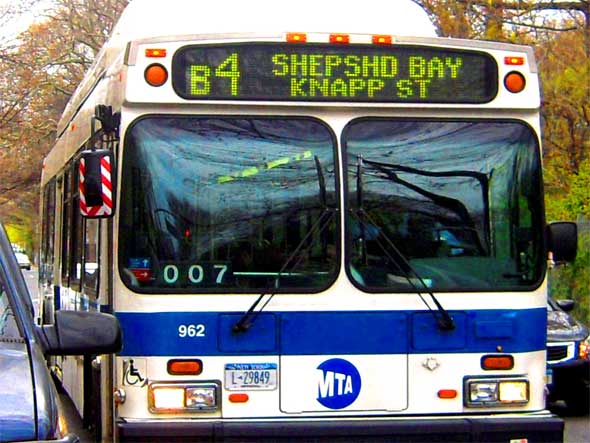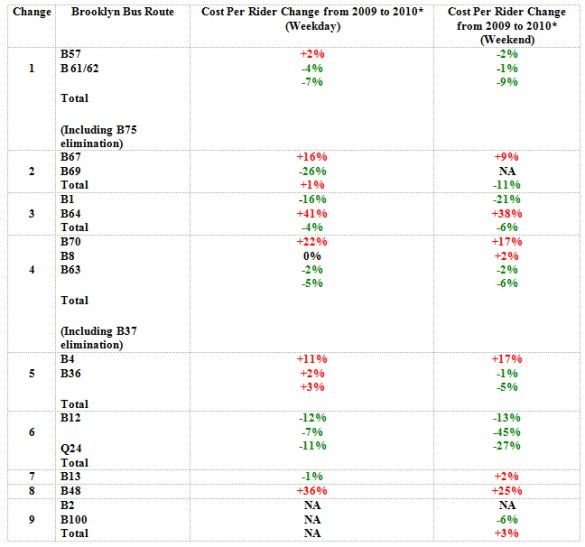MTA Releases Evaluation Of Bus Service Cutbacks

THE COMMUTE: When the MTA severely cut bus service in June 2010, they did so to help close a budget gap. Their official line was that they were cutting service to improve efficiency and to inconvenience as few customers as possible. Based on a methodology that was never fully disclosed, which I disputed in detail, connections were severed between neighborhoods, increasing the number of trips requiring three buses. By doing so, a double fare was now required for those trips (by those without unlimited ride MetroCards) and the MTA quietly reversed a policy in effect since the 1930s that no service changes would require riders to pay additional fares.
Now the MTA has quietly released a 115-page report [PDF], neatly tucked away on its website evaluating the effects of those changes.
Synopsis of Report With Commentary (in Italics)
The 2010 MTA budget gap was $300 million. Of that amount, $51.2 million in savings was achieved from bus service cutbacks and $16.6 million from subway cutbacks. Why were buses targeted so heavily and why was Brooklyn hit the hardest? The report does not address those questions. Bus ridership declined by one percent, and 15 percent of bus and subway riders were inconvenienced. Where are the absolute numbers? Why are only percentages disclosed? One percent sounds so much less than 22,000 daily passengers lost and about one million daily passengers inconvenienced. Is that the reason? This is the same type of misleading analysis the MTA used when disclosing the original service cuts. The cuts are justified as meeting their objectives because a “majority” of the riders were unaffected (p.1). So it would be okay to inconvenience 45 percent of the riders? That still would not be a majority.
Specific Conclusions Regarding Brooklyn Local Bus Route Changes (Pages B17-B35)

*My assumption is that these statistics are for the six-month periods of June through December, although this is not specified in the report. If the entire 2009 were compared to the entire 2010 (as stated in the table headings), all the numbers would nearly double to measure the true effect of the changes since the service cuts took effect on June 27, 2010, not at the beginning of the year.
The MTA was not able to provide an analysis regarding the discontinuation of routes B23, 24, 39, 51 and 71.
Change #1: Combined the B61 and B77, eliminating the B75 and extending the B57 appears to have been neutral from an efficiency standpoint. However former B75 passengers have complained of being inconvenienced by longer trips which is not reflected in the table.
Change #2: Rerouted the B69 to Seventh Avenue, appears to have not been successful on weekdays. The weekend savings of 11 percent are misleading since these savings were achieved not by combining the southern portion of these routes but by discontinuing weekend service on the B69 altogether. This inconvenienced passengers by providing no alternative service for them but longer indirect subway or bus trips probably with much extra walking or just making the trip impossible by public transit.
Change #3: Flip-flopped the B1 and B64 and discontinued the portion of the B64 between 25th Avenue and Coney Island, achieved a small savings. Again, the inconvenience of discontinuing the southern portion of the B64 is not measured. Only 25 percent of lost B64 riders shifted to B82. This is likely due to a large number of riders walking extra distances to 86th Street to board the B1 and the fact that B64 service was also severely cut last September. When viewed by itself, the cost per rider on the B64 increased by approximately 40 percent. Ridership on both routes declined but efficiency slightly increased.
Change #4: Elimination of the B37 along Third Avenue and rerouting the B70 achieved a small savings if you buy into the assumption that Third Avenue passengers walked to Fifth Avenue to ride that bus instead and then walked back to Third Avenue. When viewed by itself, the rerouting of the B70 caused it to become less efficient increasing the cost per passenger by about 20 percent.
Change #5: Elimination of the B4 in Sheepshead Bay also asks you to assume that former B4 passengers diverted to the B36, which in some cases required an extra walk of a half mile or more. If that were true, route efficiency slightly declined on weekdays and slightly increased on weekends. However, when viewing the B4 by itself, the cost per rider increased 11 percent on weekdays and 17 percent on weekends as a result of its elimination in Sheepshead Bay — clearly not a successful outcome in my opinion.
Change #6: Elimination of the B12 along Liberty Avenue appears to have been successful with a significant decrease in the cost per rider on the B12 and neighboring Q24 one block away.
Change #7: Elimination of the northern portion of the B13 appears to have been neutral from a cost perspective. However riders were inconvenienced.
Change #8: Elimination of the B48 south of Fulton Street appears to have been the worst failure by far with the route becoming less efficient on weekdays with the cost per passenger rising by 36 percent on weekdays and 25 percent on weekends. Clearly riders abandoned this route en masse rather than merely switching to the Franklin Shuttle or the B49 as the MTA predicted. Instead, they found other means of making their trips such as private car service, since many would have had to pay extra fares.
Change #9: Elimination of the B2 on weekends achieved a slight savings if you assume that riders shifted to the B100.
Change #10: Shortening of the B3 in Bergen Beach. No information given other than to state that route efficiency was decreased, but the MTA attributed this decrease to inflated ridership due to the temporary closing of the Avenue U Station prior to the service cutback making the results inconclusive.
Summary
The MTA evaluated nine of the 15 changes. From a cost efficiency point of view, the effects of two changes can be considered slightly successful (#1 and #3); one as a definite success (#6); two can be considered failures (#2 and #5), and one a dismal failure (#8) That’s three successes, three failures, and nine not evaluated, inconclusive, or neutral if you do not consider passenger inconvenience.
However, according to the MTA, the service cutbacks were generally successful because their objective of reducing costs was met. Changes such as modifying B67 and B69 schedules to reduce bus bunching in Kensington and Park Slope were made later and other refinements are yet to be made according to the MTA.
The B4
Could one of those refinements be restoring the B4? Since the B4 was cutback afternoons and evenings from Knapp Street to Coney Island Hospital, efficiency of the route has declined. Passengers have found longer indirect ways of making their trip. For example, instead of a direct bus, three subways via Downtown Brooklyn are now required to get from Sheepshead Bay to Bay Ridge or a long walk to the B1 if possible. Riders of the B68 transferring to the B4 were faced with an extra fare in one direction, during the hours the route was cutback between approximately 9:00 a.m. and 2:00 p.m. and after 7:00 p.m. and on weekends. Once someone finds an alternate route, he will most probably stick with it and not look at his watch to try to guess if the B4 is running by the time he would arrive at the transfer point.
The MTA could relocate the B4 terminal from Coney Island Hospital to Coney Island Avenue to restore a full time connection with the B68 in both directions at no cost. Also, since the B4 now requires a 20-minute layover at Coney Island Hospital, it is also doubtful if extending it at least to Sheepshead Bay Station would cost any more. Last October, I made both suggestions to Peter Cafiero, director of Operations Planning, who signed off on the service cutbacks, and he promised to investigate. One year later, I am still waiting for a response. The MTA clearly is not being responsive.
Conclusions
The MTA should admit they made a mistake at least in the cases of the B48 and the B4 and restore those routes to their pre-cutback state. Considering the B36 along with the B4 skews the statistics since ridership also declined on the B36, proving B4 riders did not shift to that route. The B4 is more inefficient at all times, not just on weekdays as the MTA claims.
Page 7 of the report states: “Note even though the remaining routes were less efficient, the projected savings were still achieved.” That is proof that the MTA’s only purpose in making the cutbacks was and still is to operate the least amount of service it can politically get away with regardless of the inconvenience to the passengers or negative effects on efficiency.
Just as the MTA declared the service cutbacks a success in spite of what the data show at least for Brooklyn local bus routes, they will also declare the B44 Select Bus Service (SBS) a success.
You Can Make a Difference
Attend Community Board 15’s monthly meeting on October 25 and ask them questions about their SBS plan for Nostrand Avenue. (Time and place of meeting to be announced.) Let the MTA know if you would prefer the SBS to terminate at Sheepshead Bay Station instead of at Knapp Street.
Also demand they restore the B4 to Knapp Street when it operates, since the cutback has made the route significantly less efficient. If we stand united, our elected officials will back us up. If we keep quiet or just quietly complain to each other, the MTA will continue to do whatever it wants, right or wrong. They must either be responsive or perhaps the time has come to return control of the subways and buses to the city. Maybe, in addition to occupying Wall Street, it’s also time to occupy the MTA.
The Commute is a weekly feature highlighting news and information about the city’s mass transit system and transportation infrastructure. It is written by Allan Rosen, a Manhattan Beach resident and former Director of MTA/NYC Transit Bus Planning (1981).